3 strategies for dynamic professional learning

Challenge. Over the years, schools, districts, and educational organizations have been criticized for the traditional ways they offer professional learning for teachers. Typically, they schedule professional learning sessions at times that don’t offer teachers flexibility, choice, or differentiated learning opportunities. Today the challenge they face is how to convert the one-size fits all model for new, experienced, and veteran teachers into differentiated professional learning experiences.
Vision. I envision professional learning as a process for teachers to ask new questions, think deeply and creatively, and connect with each other to generate new ideas and solutions for their specific teaching assignments and students. One promising model for achieving this vision is Dynamic Professional Learning.
The Back Story. Recently, much has been written and shared about differentiating and personalizing learning for students in K-12 classrooms through blended learning models. Basically, blended learning combines both online and in-person learning experiences to offer an array of methods and tools to differentiate and meet student needs and preferences. Using blended learning, students acquire data and information online and, then, apply what they learn to solve problems in a face-to-face classroom setting. Innovative blended learning models you may know about include the flipped classroom; station, lab, and individual rotation; flex; a la carte; and enriched virtual.
The Opportunity. Professional educators are now asking the question: If these engaging blended learning models for students are supported by teachers in classrooms and online for differentiating learning, what would happen if the features of blended learning models were adapted to differentiate the professional learning of teachers? I believe the answer to that question would result in a dynamic professional learning model.

A Dynamic Professional Learning Model. Think out of the box for a minute. What if professional learning was offered entirely over the Internet? That’s right. It wouldn’t blend online and in-person professional learning. It would blend:
What teachers do best — nurture, facilitate, teach, and support — with what technology does best — process information at the speed of light.
In this virtual dynamic professional learning model teachers become colleagues; join teams; learn; collaborate in subject matter, grade level, or school cohorts; and share products, performances, and results related to their classrooms and students.
Let’s Consider How It Works. Three virtual strategies support the dynamic professional learning model — a professional learning coach and team and self-paced strategies. They help teachers to complete practice, development, collaboration, and assessment activities and to demonstrate real-world actions expected with students in their classrooms. Professional learning activities are delivered in learning layouts, a new virtual way of mixing people, teaching, and technology. Text, graphics, animations, video, and social learning tools such as microblogs, colleague and team messages, and instant messaging support each learning and practice activity. Other digital tools support the tasks of teaching — lessons, tests, graphic organizers, data displays — and are integrated with social learning tools for rapid sharing among teachers. All of that means teachers would have control over content, time, place, preferred digital device, and pace for when, how, and where they do professional learning. Does that sound like using differentiated strategies for dynamic professional learning? I think so.
Strategies for Differentiating Professional Learning. In the dynamic professional learning model, the following three virtual strategies would support differentiated opportunities for teachers to learn and improve continuously.
– Professional Learning Coach: For this strategy, school or district subject matter, instruction, mentoring, and assessment experts would serve as online professional learning coaches for teachers. They would facilitate discussions, receive teachers’ practice activities and provide feedback, analyze products developed for their classrooms, and provide comments for improvement.
– Team Strategy: In the Team Strategy, teachers complete learning layouts working as a virtual cohort, in action teams, and independently as part of a scheduled webinar supported by a coach and web conference tool for team and breakout sessions. Teachers submit practice activities and products to their coach, colleagues, and teams for formative feedback and to their coach to confirm completion and earn badges. The Team Strategy can include brief coaching sessions for individual teachers during the scheduled webinar.
– Self-Paced Strategy: In the Self-Paced Strategy, teachers complete learning layouts independently, at their own pace, in their preferred location, with their preferred digital device, and submit practice activities and products to their coach, colleagues, and teams for formative feedback and to their coach to confirm completion and earn badges. The Self-Paced Strategy can include brief coaching sessions for individual teachers in a scheduled web conference.
The Payoff. The coach, team, and self-paced strategies maximize differentiated professional learning by leveraging the skill sets of cohort teachers to offer peer instruction and feedback. For example, because all participating teachers are skilled professionals, a 1:20 coach-teacher ratio gets converted to a 20:1 coach-teacher ratio facilitated by the professional learning coach. The capacity of these virtual strategies to flip coach-teacher ratios is the major difference between traditional and dynamic professional learning models in a virtual learning community.
Dynamic professional learning recognizes that teachers are learners with the know-how to engage people, strategies, and technology, based on a vision, to create new and better ways of learning.
 This is a guest post written by Nicholas Hobar (@nickhobar), president of the dynamic learning community LearningFRONT. Nick is connecting the individual and collective talents of teachers, trainers, employers, and experts worldwide to create new and better ways of learning. Nick is also an affiliate professor at Loyola University Maryland, teaching graduate classes on integrating professional learning into technology.
This is a guest post written by Nicholas Hobar (@nickhobar), president of the dynamic learning community LearningFRONT. Nick is connecting the individual and collective talents of teachers, trainers, employers, and experts worldwide to create new and better ways of learning. Nick is also an affiliate professor at Loyola University Maryland, teaching graduate classes on integrating professional learning into technology.


pidgin
July 18, 2019 at 7:24 pmSuch a nice explanation, thanks Nich!